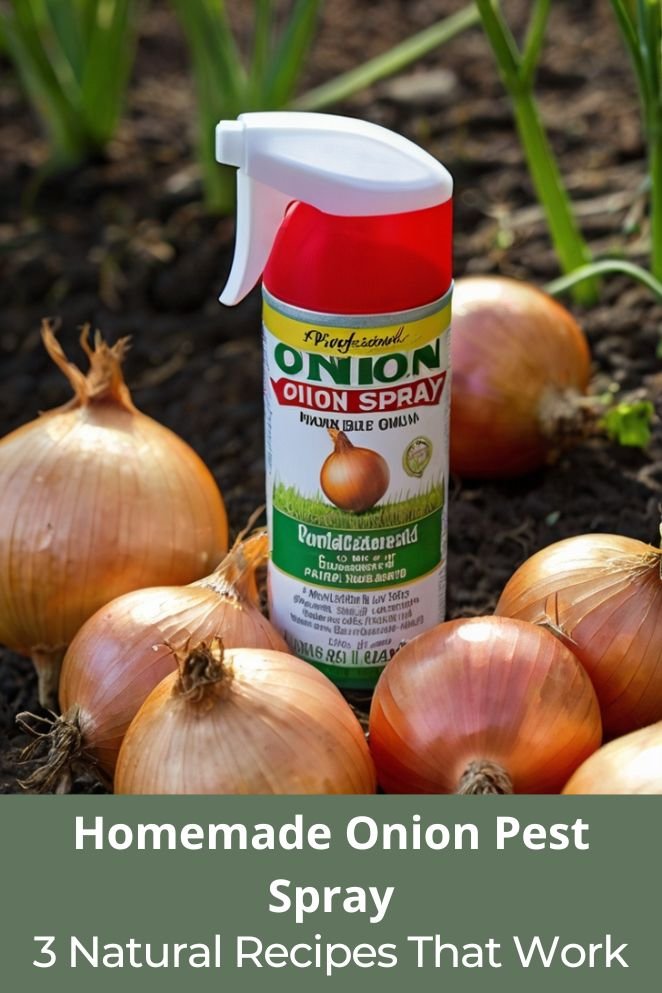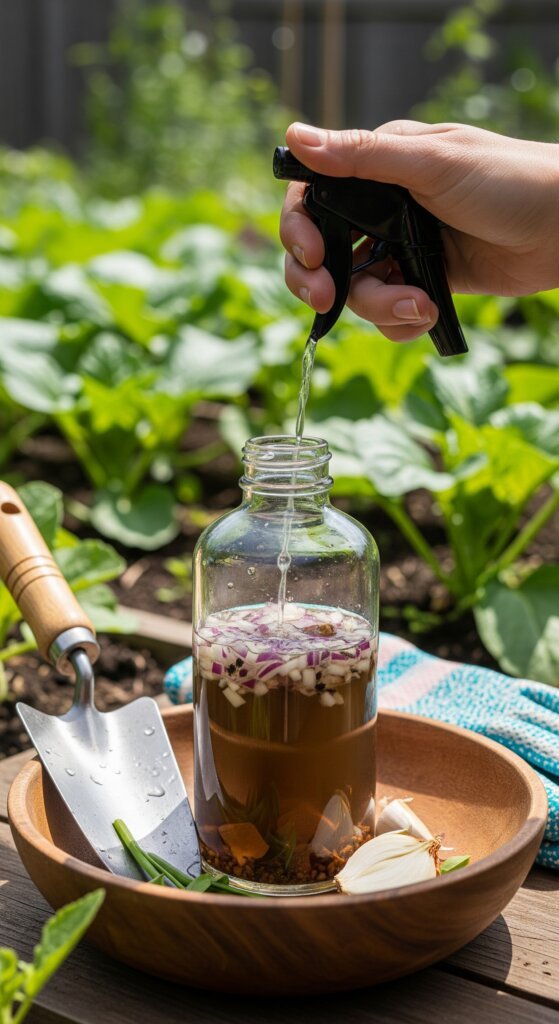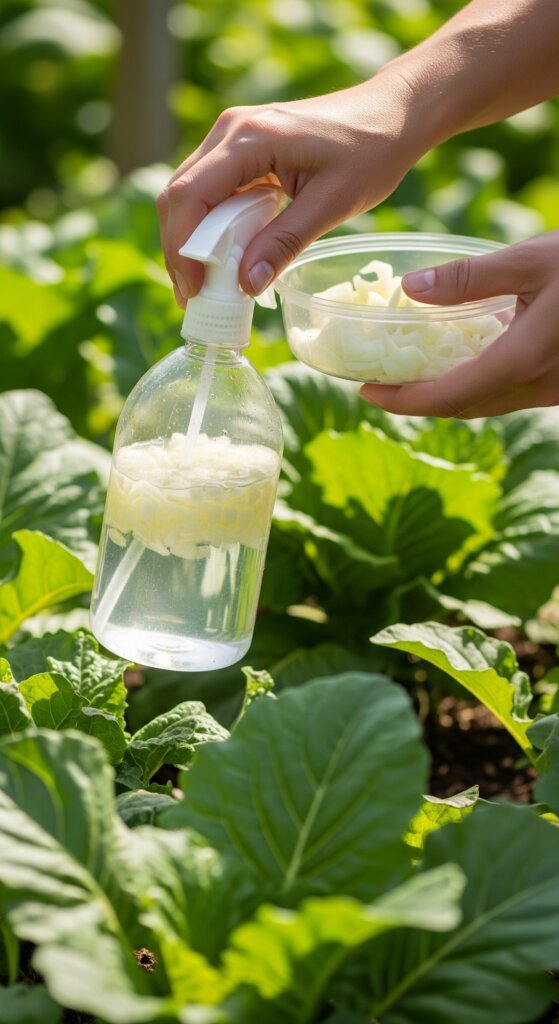
Bugs turning your veggies into an all-you-can-eat buffet? Grab an onion—not bug spray.
That stinky kitchen staple is packed with sulfur and compounds that pests like aphids and beetles can’t stand.
In this guide, you’ll get 3 super simple, budget-friendly onion spray recipes to keep the bad bugs out—no chemicals, no guilt.
Let’s peel into it.
Benefits of Using Onion Pest Spray in Your Garden
Before we get cookin’ with those onion sprays, here’s why this humble veggie deserves a spot in your garden toolkit:
- Totally natural – No harsh chemicals here. Onion spray is safe for your leafy greens, your buzzing pollinators, and even your curious pets. Mother Nature approves.
- Cheap and cheerful – Got onion scraps? Boom. You’re halfway there. No need to drop cash on fancy store-bought sprays.
- Multi-bug bouncer – Aphids, spider mites, cabbage worms—onion doesn’t discriminate. It tells all the creepy crawlers to take a hike.
- Eco-friendly AF – Onion spray breaks down naturally, so your soil and water stay as pure as your garden intentions.
Why does it work? It’s those funky sulfur compounds (like allicin) that smell like trouble to bugs but spell safety for your plants.
Think of it as nature’s bug spray with built-in sass.
- Read also: Repel and Trap: DIY Lettuce Pest Traps That Actually Work
- Read also: Homemade Repellent: DIY Natural Pesticide Spray for Mosquitoes
3 Natural Onion Pest Spray Recipes

Recipe 1: Basic onion and garlic garden spray
Best for: Aphids, whiteflies, spider mites—basically any uninvited garden guests.
What you need:
- 1 big ol’ onion
- 1 full garlic bulb (around 10 cloves)
- 1 tsp liquid castile soap (optional, but helps it stick like gossip on a group chat)
- 1 liter (4 cups) of water
How to make it:
- Peel and chop your onion and garlic like you’re prepping for soup.
- Toss it in a blender with 2 cups of water. Blend until it’s a funky-looking smoothie.
- Strain that mix using a fine mesh strainer or cheesecloth (because chunky bug spray is a no-go).
- Add the other 2 cups of water and mix in your soap.
- Pour it all into a spray bottle. Boom—done.
How to use it:
- Shake it like a Polaroid picture before every use.
- Spray directly on your plant leaves—especially the undersides (that’s where bugs like to party).
- Best times? Morning or evening, when it’s cooler and your plants are chill.
- Reapply every 5–7 days or after a heavy rain washout.
Pro Tip: Test on one leaf first, just to make sure your plant doesn’t throw a fit. Plants have feelings too (sort of).
Recipe 2: Onion and chili pepper spray
Best for: Beetles, caterpillars, and yes—those nosy squirrels who think your tomatoes are a snack.
What you’ll need:
- 2 medium onions
- 2 hot chili peppers (or 1 tbsp red pepper flakes if you’re raiding the spice rack)
- 1 tbsp dish soap or insecticidal soap
- 1 liter (4 cups) of water
How to make it:
- Toss your onions and chili peppers in the blender with water—yes, you’re basically making garden hot sauce.
- Let the spicy smoothie sit for at least an hour so it gets extra bold (like espresso, but for pest defense).
- Strain through a cheesecloth or fine strainer—no chunky bits allowed.
- Stir in the soap to help it stick to the leaves like gossip on garden TikTok.
- Pour into a labeled spray bottle so no one mistakes it for salad dressing.
How to use it:
- Spray in the evening to avoid sunburnt leaves—plants get touchy in direct sunlight.
- Hit the base of your plants and the leaves (especially where bugs munch).
- Wear gloves! Capsaicin is spicy stuff—it can irritate your skin and definitely your eyes. This isn’t hot sauce, folks.
Why it works:
Capsaicin from chili peppers turns the onion’s natural stink power up to 11.
It’s like putting your garden in invisibility mode—for pests.
Chewing bugs and even furry foragers hate the taste and smell.
It’s organic, effective, and just the right kind of extra.
Recipe 3: Onion skin tea spray
Best for: General pest control, soil booster, and giving your plants a weekly wellness shot.
What you’ll need:
- Skins from 3–4 large onions (yep, the papery bits you usually toss)
- 1 liter (4 cups) of water
How to make it:
- Dump those onion skins into a pot. Add water.
- Bring to a boil like you’re making soup for your plants.
- Simmer for 30 minutes. Let it cool and steep overnight—just like your favorite herbal tea.
- Strain out the skins (unless you want garden broth with pulp).
- Pour into a spray bottle and you’re good to go.
How to use it:
- Spray all over your garden beds and leaves once a week—think of it as pest-prevention spa day.
- Bonus move: Pour leftover tea at the base of your plants for a soil nutrient boost.
Why it works:
This mellow brew is packed with quercetin—a natural antioxidant found in onion skins that may help boost plant immunity (basically the echinacea of your garden).
It won’t knock pests out cold, but it keeps them from showing up in the first place.

Tips for Best Results
Want your onion sprays to go full superhero mode in the garden?
Follow these quick tips to level up your pest-fighting game—because even the best DIY potion needs a little strategy behind it.
Application guidelines
- Timing is everything – Always spray in the cool hours—early morning or at sunset—unless your goal is steamed veggies on the vine.
- Patch test first – Hit a few leaves before you go full plant facial. Some delicate greens get fussy.
- Keep it consistent – Reapply once a week, and especially after rain (because nature’s rinse cycle undoes your hard work).
Storage
- Chill it – Pop your spray in the fridge to keep it fresh for up to 7 days.
- Label like a boss – Write what it is and the date. Trust us, you don’t want someone mistaking this for salad dressing.
- Keep it safe – Store where curious pets and tiny humans can’t access. Capsaicin + kids = chaos.
Companion strategies
- Plant buddies – Pair your onion sprays with natural pest-repelling pals like marigolds, basil, or chives for double the defense.
- Cover up – Use row covers to block pests from even sniffing your crops. It’s like crop invisibility.
- Crop swap – Rotate your planting zones each season to confuse pests. No repeat buffet zones for them.
Pests Commonly Repelled by Onion Sprays
Here’s a quick reference of pests that may be deterred using onion-based garden sprays:
| Pest Type | Effectiveness |
| Aphids | High |
| Spider Mites | Moderate |
| Whiteflies | High |
| Leaf Miners | Moderate |
| Cabbage Worms | Moderate |
| Beetles |
Moderate to High
|
| Squirrels | Moderate |
While onion sprays are not a silver bullet, they are an excellent first line of defense in any integrated pest management plan.

- Read also: DIY Insecticidal Soap Spray: Protect Your Plants Without Harsh Chemicals
- Read also: DIY Solution: Homemade Plant Insect Spray for a Healthy Garden
FAQs About Onion Pest Sprays
Most leafy greens, herbs, and flowers tolerate onion sprays well. Avoid spraying on delicate petals or during full sunlight to prevent burns.
Yes, but test the mixture on indoor plants first and ensure good ventilation due to the strong smell.
They mostly repel by masking plant scents or irritating insect senses.
Conclusion: Your Garden, Your Rules—Naturally
Turns out onions aren’t just for making you cry—they’re garden heroes too.
With a few peels, some DIY magic, and zero chemicals, you can keep pests out and good vibes in.
Test all three onion sprays, stay consistent, and mix in other natural tricks.
Your plants stay bite-free, your soil stays happy, and Mother Earth gives you a high-five.
Bottom line? You’re not just gardening—you’re running a pest-free fortress. Powered by onions.



